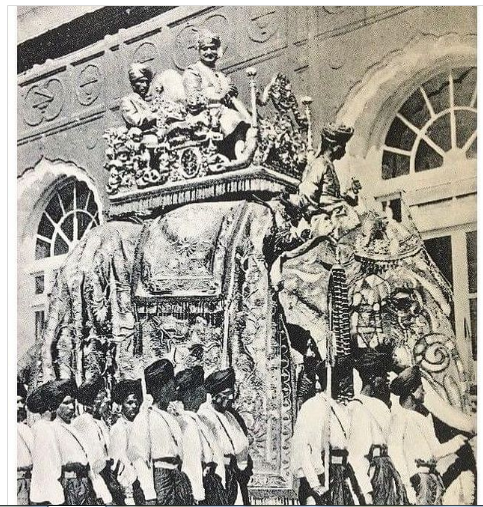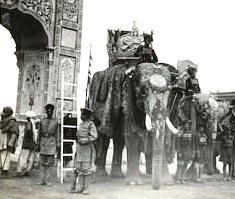(Kashmir Rechords Exclusive)
Once a place for keeping Royal Elephants, it is now a famous Sabzi Mandi (Vegetable Market) of Jammu City!
Situated in the heart of old Jammu city near Parade Chowk with Moti Bazar on the other side, a large open area was once called Hathithan, a stable or Camp for elephants, belonging to Dogra Maharajas of Jammu and Kashmir.
There is a mention of the same in a book on the “History of Elephants in Jammu and Kashmir’’, written in Urdu. The book describes a story of the Royal elephants who were brought to the Princely State by Maharaja Gulab Singh in 1846.
Written by Abdul Latif, a son of the senior Mahout who died in 1933, the book deals with several incidents and events connected with the elephants of the rulers in the Princely State. Abdul Latif’s grandfather was also a Mahout working for the Dogra rulers.

From 3 to 20 Elephants
According to the Author of the Book, published in 1971, Maharaja Gulab Singh had brought three royal elephants into Jammu which were kept at Hathithan, now the famous Parade Chowk Sabzi Mandi of Jammu. The number of elephants had risen to 20 when Maharaja Ranbir Singh (1856) ascended the throne.
In 1870, an elephant Rama gored his Mahout to death. This had enraged Maharaja Ranbir Singh who is said to have himself enquired about the reason for Rama Elephant’s unusual fury. Latif says, “When the Maharaja approached Rama, the elephant with its trunk collected the dust and divided it into two parts giving an idea to the ruler that he was annoyed since his master was pilfering his rations’’.
Jamuna Dass—The Senior Royal Elephant
The Author says Jamuna Dass was the senior most elephant during Maharaja Pratap Singh’s reign (1885-1925). One more elephant, Ganga Dass had joined him after some years. Jamuna Dass had its own majestic personality. He always used to give a grandeur look, remaining calm and sobre on all occasions. But on the other hand, Jamuna Das used to become violent and irate at times.
As the royal seat during those times remained at Mubarak Mandi Palace which served both the Royal Court and Residential Palace, the then Hathithan was not more than a kilometer away from the Palace. These elephants were kept at this place and used to be tied with a large banyan tree that still exists there.
According to Shiv Chander Sharma, a noted Journalist from Jammu, the side gates of Hathi Khana of those times still exist but were generally ignored by the people who mostly visit the area to buy vegetables only.
Prince Edward’s Visit to Jammu
 Excerpts of a Book Review of “History of Elephants in Jammu and Kashmir”, published in Daily Excelsior on January 30, 1971.
Excerpts of a Book Review of “History of Elephants in Jammu and Kashmir”, published in Daily Excelsior on January 30, 1971.
In a Book review, published in a local newspaper (Daily Excelsior) on January 30, 1971, the Author Latif mentions that Jamuna Dass was selected for the royal procession at the time of the coronation of George V at Delhi. Jumna Dass was fortunate enough to have a pat from the Emperor.
Edward’s 1922 Visit to Jammu. Three Royal elephants were chosen for a ceremonial arch. (Photo Courtesy: Royal Collection Trust)
Similarly, during the visit of Edward, the Prince of Wales (later King Edward VIII) to Jammu (1922), three elephants with highly decorated howdahs on their backs were chosen for a ceremonial arch. After a banquet and fireworks display, the Prince and the Maharaja were later escorted on elephants to the Maharajah’s Royal camp at Satwari Cantonment, a few miles away from Jammu.
According to Author Latif, the royal stable had mostly two male elephants at a time but the number of female elephants was never less than 15 with various names.


Very intersting information.